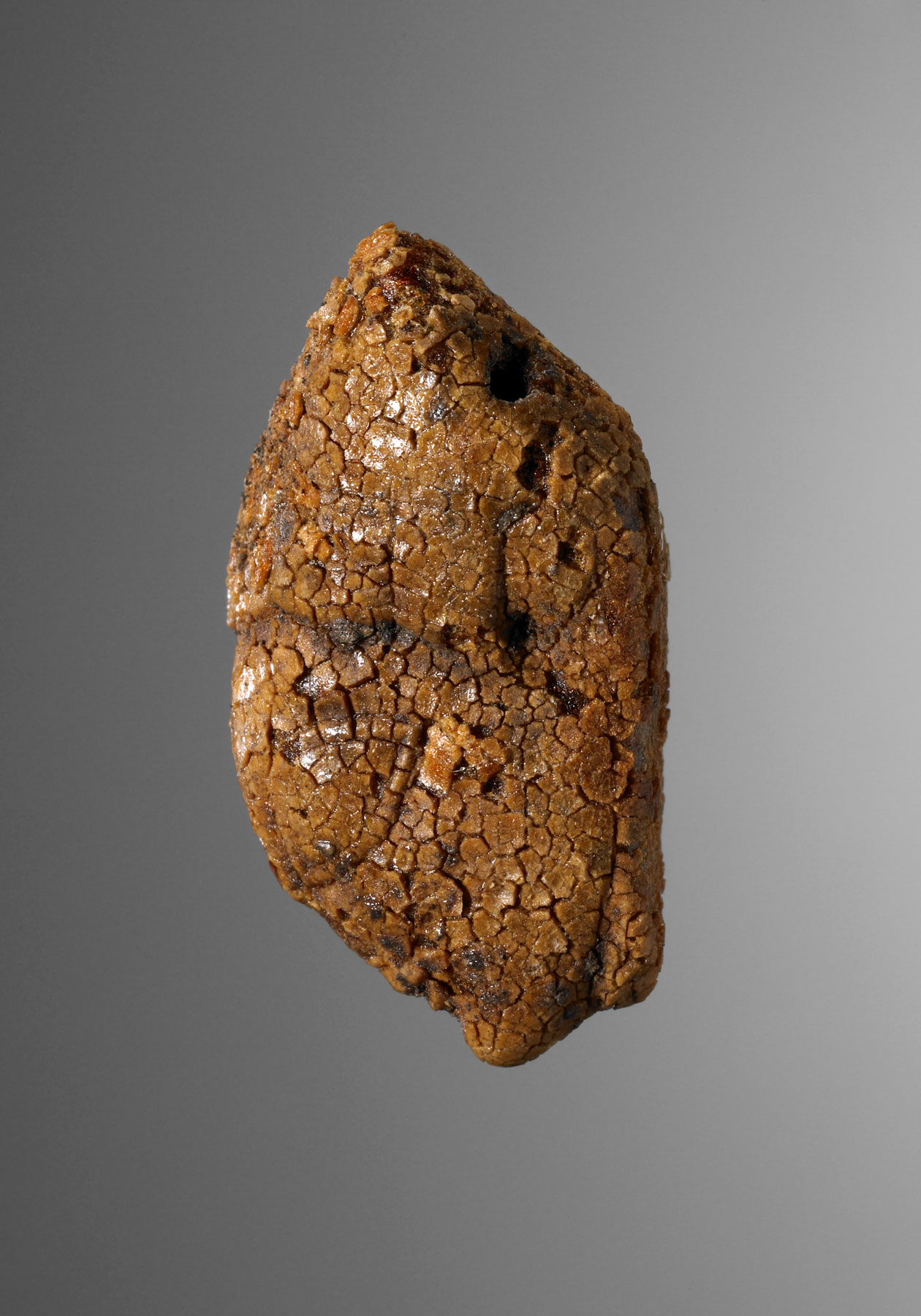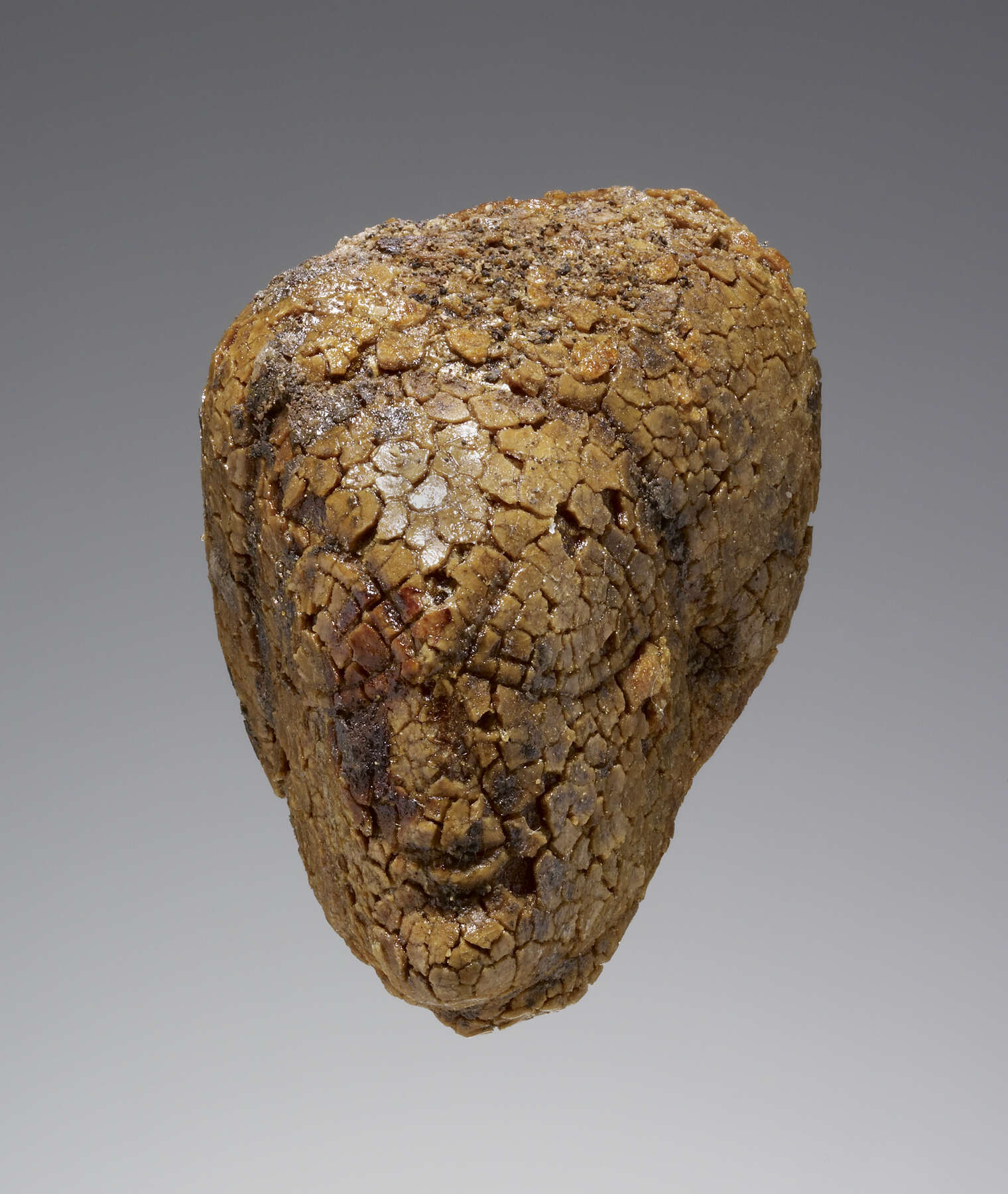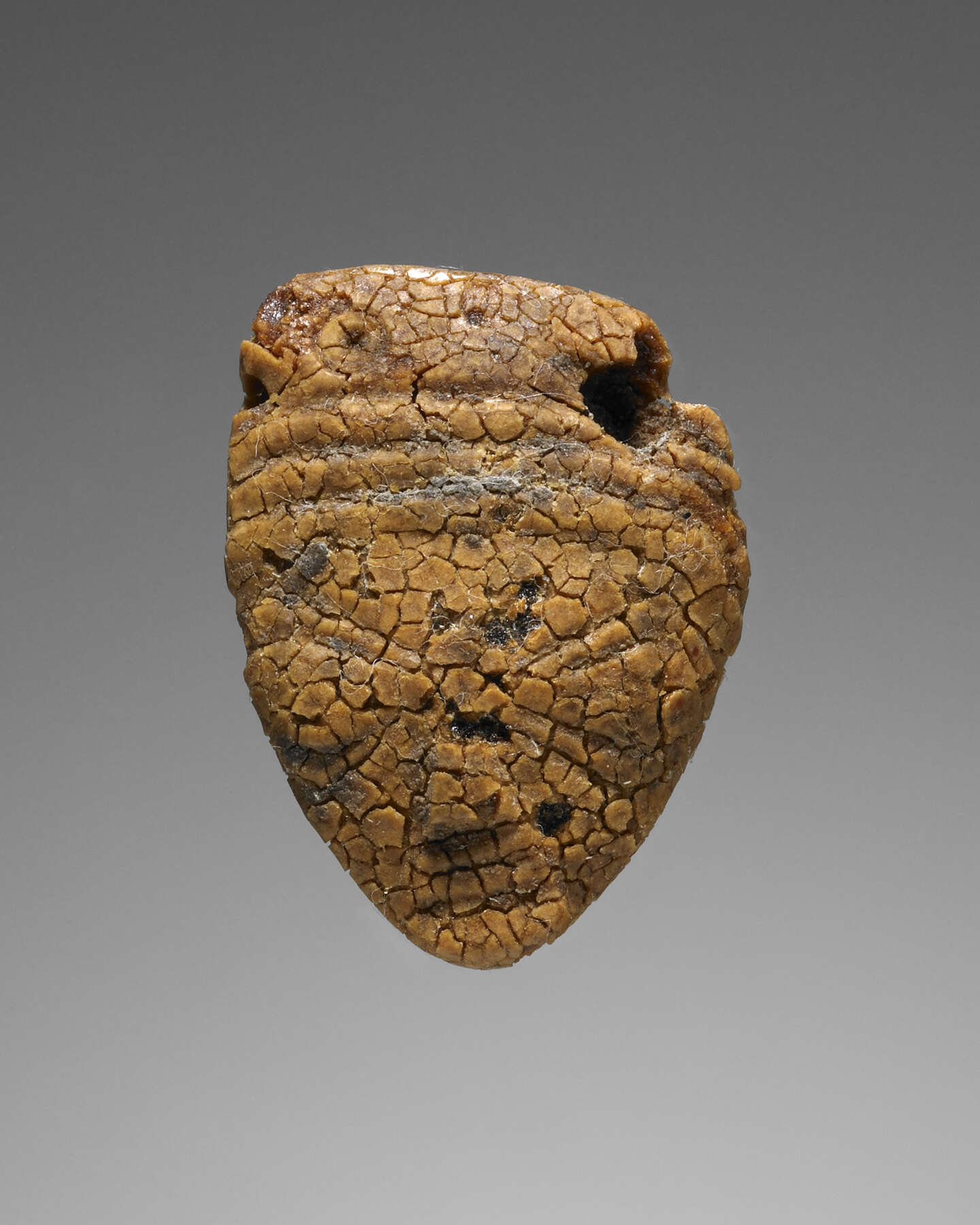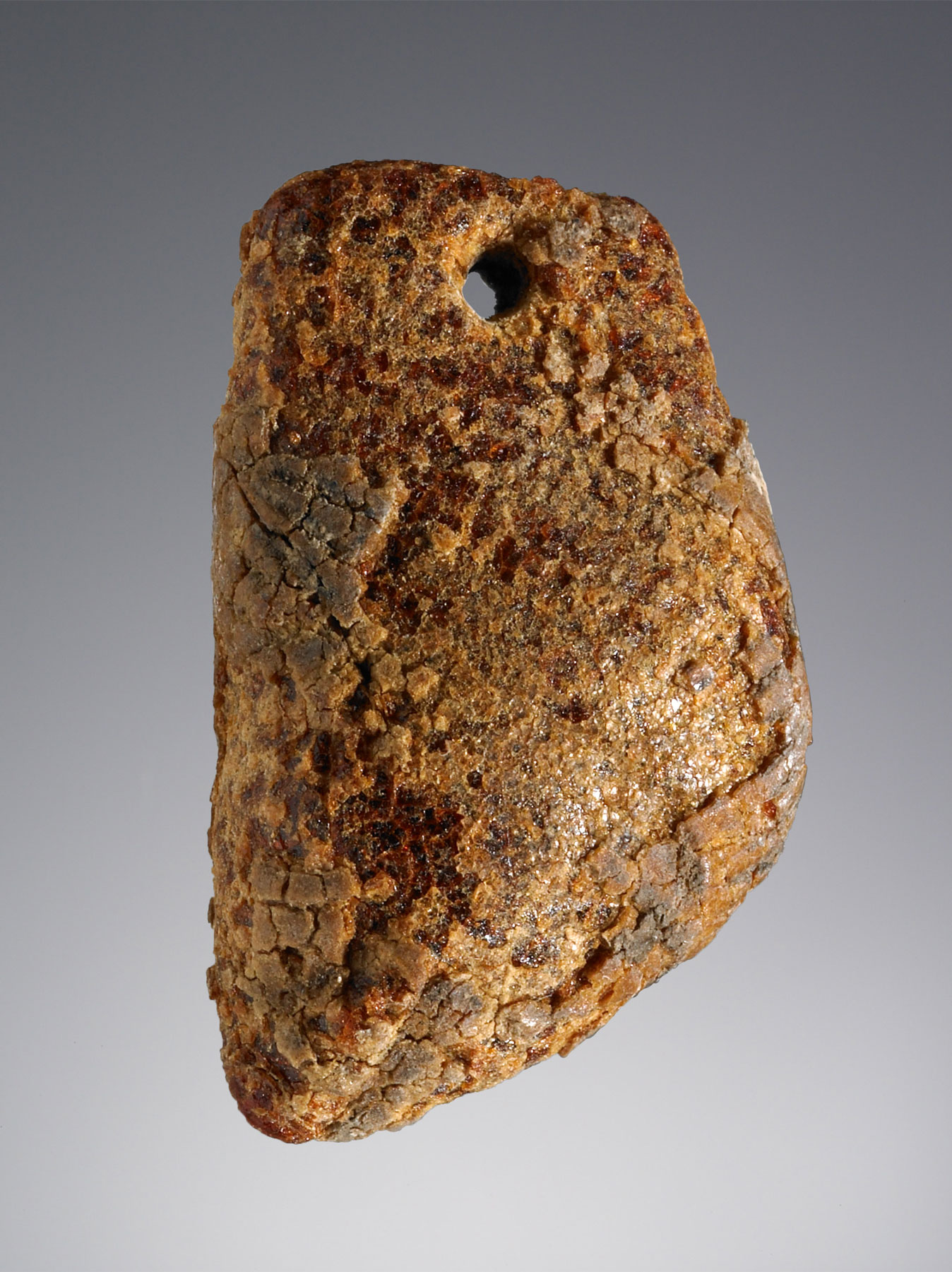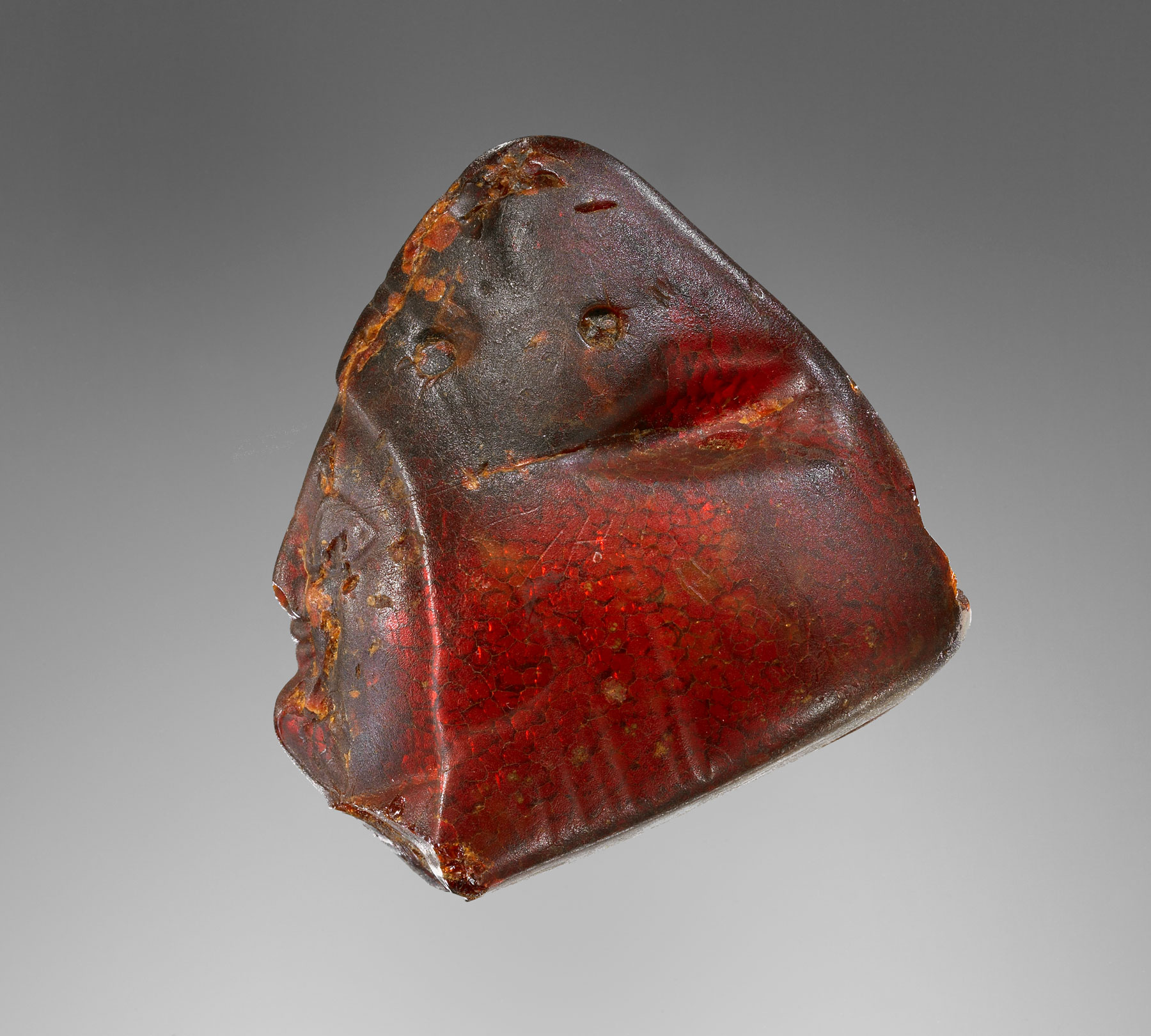18. Pendant: Female Head
| Accession Number | 83.AO.202.4 |
| Culture | Italic |
| Date | 425–400 B.C. |
| Dimensions | Height: 40 mm; width: 23 mm; depth: 16 mm; Diameter of suspension hole: 2 mm; Weight: 4 g |
| Subjects | Etruscan culture |
Provenance
–1983, Antike Kunst Palladion (Basel, Switzerland); 1983, Vasek Polak, 1914–97 (Hermosa Beach, CA), donated to the J. Paul Getty Museum, 1983.
Condition
The pendant is intact, but the nose is broken off. The surface is in poor condition and flaking, there are small losses over the entire piece, and it has a network of cracking. The surface is slightly glossy, suggesting an applied consolidant coating. The entire surface of the pendant is covered in a weathered yellow-ocher crust. In ambient light, the amber is yellowish brown and opaque; in transmitted light, it is dark red and clear. There are no visible inclusions.
Description
The contortion of the form and the asymmetry of the headdress suggest that the original amber blank influenced the form of the head. The pendant represents the frontal head and a small section of the neck of a female. The reverse is flat and plain, the obverse much more rounded and figured. Although the piece is worn and looks almost inorganic, the anatomy of the narrow face is modeled, including the eyeballs. The transitions from plane to plane are smooth. The brow is high and smooth, with the edge of the hair set well back. Above the eyes, the brow ridge swells slightly. The large, almond-shaped eyes meet at the root of the nose and tilt up sharply, the outer canthi higher than the inner, and both the upper and lower lid lines curve. The eyelids are unusual, flat and circumscribed by even, filletlike raised lines. The upper parts of the ears are not discernible. Where the lobe of the ear would be is a small rounded area: is it the lobe or an earring? The mouth is small and curves upward. The lips are separated by a groove. The lower lip is wider than the upper one. The sulcus is curved, leading to the sharply pointed chin. The under-chin area is flat and angles backward to the jaw. The juncture of the head and neck is indicated by a groove. More of the neck vestige is visible on the left side. Framing the face at the brow are scalloplike waves, the individual strands indicated with curving parallel lines. Above the hair is a headdress that is wider than the brow and ends in a soft point. At its base is a slightly rounded, raised area bordered by two parallel engraved lines, which probably represent either the turnup of a felt(?) hat or the bottom of the hat and the edge of the veil. Alternatively, they may represent just the edge of the veil. There is no evidence of hair at the back or sides of the head.
A 2 mm suspension perforation extends through the headdress near the top, but both holes are on the left side. This would have made the frontal head hang in profile. When suspended, the head tilts forward, with the back perpendicular to the ground.
Discussion
This head-pendant was in the same donation group as four other female head-pendants: (cat. no. 19), (cat. no. 20), (cat. no. 21), and (cat. no. 22). All five are alike in size, condition, and general typology. All are asymmetrical and have off-center suspension perforations that cause them to hang crookedly. Although they are different in style and details of dress, it is possible that they come from the same original context. Figured ambers of different style, date, and type are often found in the same burial.
83.AO.202.4 is dressed in a high conical hat covered with a veil. and each wear a conical cap that is set off from the straight bangs by a pair of spaced engraved lines, perhaps representing the turnup or roll-up of the cap (perhaps made from felt). The flange of amber at the back of the head of likely represents a wing.
The combination of cap, earrings, and veil of 83.AO.202.4 is the same combination worn by the figure of another Getty head-pendant (, cat. no. 14) and by one of the British Museum heads in-the-round (BM 45).1 The Getty head-pendant (cat. no. 25) is dressed in a cap (but has no veil). A much larger head-pendant in Cleveland has her hair dressed in scalloped waves at the brow like 83.AO.202.4, but like (cat. no. 26), the Cleveland figure wears a crown in addition to the cap.2 The straight bangs topped by the cap of and is a more common fashion than that of 83.AO.202.4—which is also worn by the imposing frontal head-pendants of a heavy-faced woman in London (British Museum 48–51).3 Two unprovenanced profile head-pendants in a London private collection represent a figure of the same physical type. They each wear a cap and have hair coifed like that of 83.AO.202.4. The profile, but not the garments, of 83.AO.202.4 is comparable to the faces of a pair of legless sirens excavated from Tomb 43 at Melfi, to one of the heads from the Melfi Tomb 48 burial, and to one of the heads from Tomb 428 at Banzi.4 The profile is also not far from that of a head-pendant in London (British Museum 52).5
This group of female head-pendants are characterized by their elaborate hair fashions and head coverings—hats, veils, and crowns—and occasionally by their earrings. The dress depends on Etruscan fashion, and the style can be traced to Etruscan inventions. Despite their schematic depiction, these tiny amber pendants clearly reflect the art of the votive bronzes placed by Emeline Richardson in her Late Archaic Series, many of them in her Group A, Ionians.6
Notes
- , p. 68, no. 45, pl. XX. ↩
- Cleveland Museum of Art 1992.61 (Andrew R. and Martha Holden Jennings Fund). ↩
- , pp. 69–71, nos. 48–51, pls. XXI–XXII. ↩
- For illustrations of the comparable head-pendants, see , pp. 70 (siren), 121 (head from Melfi), 122, 125, 127 (head from Banzi). ↩
- , p. 71, no. 52, pl. XXII. Strong compares this head to one found at Populonia ( ser. 6, 2 [1926]: 326), to a head in Bari (inv. 6598), and to the Valle Pega heads from Tomb 640B and Tomb 514A. I know the heads from Populonia and Bari only from photographs. The Valle Pega head from Tomb 514A looks less like this Getty head-pendant than does that from Tomb 640B. ↩
- , pp. 271–302. ↩
Bibliography
- Magie d’ambra 2005
- Magie d’ambra: Amuleti e gioielli della Basilicata antica. Exh. cat. Potenza, 2005.
- Richardson 1983
- Richardson, E. H. Etruscan Votive Bronzes: Geometric, Orientalizing, Archaic. 2 vols. Mainz am Rhein, 1983.
- Strong 1966
- Strong, D. E. Catalogue of the Carved Amber in the Department of the Greek and Roman Antiquities. London, 1966.
